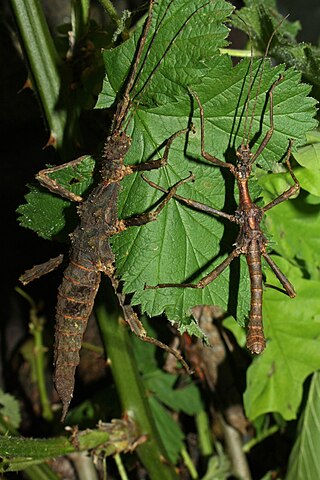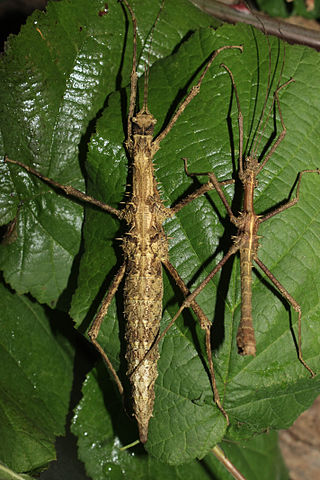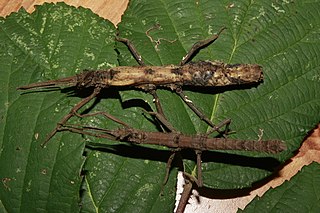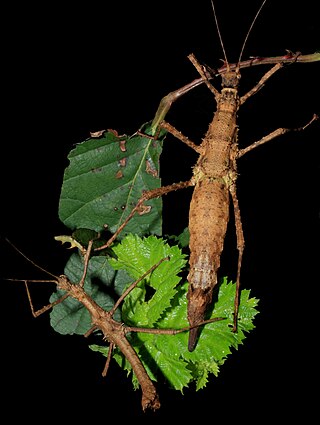
Aretaon is a genus of stick insects native to Borneo and the Philippine island Palawan.

Trachyaretaon is a genus of stick insects native to the Philippines.

Brasidas is a genus of stick insects that is native to the Philippines and is named after the Spartan general Brasidas

Obrimus is a stick insect genus native to the Philippines. It is type genus for the tribe and the subfamily in which it is listed.

Eubulides is a stick insect genus native to the Philippines.
Trachyaretaon gatla is a species of Phasmatodea native to the Philippine island Palawan.
Brasidas foveolatus is a species of stick insects from the family Heteropterygidae native to the Philippine archipelago Mindanao.

Brasidas cavernosus is a representative of the stick insects native to the Philippine island Luzon. It is considered one of the largest species in the subfamily Obriminae.

Pylaemenes mitratus is a species of stick insects (Phasmatodea) native to Malay Peninsula and Sumatra. The species is also known by the common name Money Plant Stick Insect, which refers to the most well-known food plants, Epipremnum aureum, which is also known as money plant.
Pterobrimus is a monotypic genus of stick insects (Phasmatodea), containing the species Pterobrimus depressus, which is native to Fiji.

Tisamenus lachesis is a stick insect species (Phasmatodea), in the family of the Heteropterygidae endemic to the Philippine Polillo Island.
Tisamenus cervicornis is a stick insect species (Phasmatodea), in the family of the Heteropterygidae endemic to the Philippine island Luzon in the province of Camarines Sur.

Brasidas lacerta is a species of stick insect in the family Heteropterygidae which is endemic to Mindanao. Due to its extreme variability, and the nymphs being spinier than to the adults, the species has been described under other names, resulting in a total of seven synonyms.

Trachyaretaon bresseeli is a species of stick insects in the family Heteropterygidae. It is native to the Philippine island Luzon.

Eubulides timog is a stick insect species from the family of the Heteropterygidae. Although only described in 2023, this species, native to the south and east of the Philippine island Luzón, has been kept and bred in the terrariums of enthusiasts since 2009.

Eubulides igorrote is a stick insect species from the family of the Heteropterygidae native to the Philippine island of Luzon.

Obrimus bicolanus is a stick insect species from the family of the Heteropterygidae native to the southeast of the Philippine island of Luzon, more precisely in the Bicol Region.

Obrimus bufo is a stick insect species from the family of the Heteropterygidae native to the Philippine island of Luzon.

Obrimus mesoplatus is a stick insect species from the family of the Heteropterygidae native to the Philippine island of Luzon.

Haaniella echinata is a stick insect species that is native to the entire north of Borneo. After Haaniella scabra, it is the representative of the genus Haaniella that inhabits the highest biotopes on Borneo.













